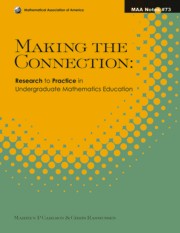Book contents
- Frontmatter
- Preface
- Contents
- Part 1 Student Thinking
- 1a Foundations for Beginning Calculus
- 1b Infinity, Limit and Divisibility
- 5 Developing Notions of Infinity
- 6 Layers of Abstraction: Theory and Design for the Instruction of Limit Concepts
- 7 Divisibility and Transparency of Number Representations
- 1c Proving Theorems
- 8 Overcoming Students' Difficulties in Learning to Understand and Construct Proofs
- 9 Mathematical Induction: Cognitive and Instructional Considerations
- 10 Proving Starting from Informal Notions of Symmetry and Transformations
- 11 Teaching and Learning Group Theory
- 12 Teaching for Understanding: A Case of Students' Learning to Use the Uniqueness Theorem as a Tool in Differential Equations
- Part 2 Cross-Cutting Themes
- About the Editors
7 - Divisibility and Transparency of Number Representations
from Part 1 - Student Thinking
- Frontmatter
- Preface
- Contents
- Part 1 Student Thinking
- 1a Foundations for Beginning Calculus
- 1b Infinity, Limit and Divisibility
- 5 Developing Notions of Infinity
- 6 Layers of Abstraction: Theory and Design for the Instruction of Limit Concepts
- 7 Divisibility and Transparency of Number Representations
- 1c Proving Theorems
- 8 Overcoming Students' Difficulties in Learning to Understand and Construct Proofs
- 9 Mathematical Induction: Cognitive and Instructional Considerations
- 10 Proving Starting from Informal Notions of Symmetry and Transformations
- 11 Teaching and Learning Group Theory
- 12 Teaching for Understanding: A Case of Students' Learning to Use the Uniqueness Theorem as a Tool in Differential Equations
- Part 2 Cross-Cutting Themes
- About the Editors
Summary
It is easy for colleagues to agree that students' understanding is one of the main goals of instruction. It is considerably more difficult to agree on what good understanding of a specific concept entails and how it is possible to achieve it or to assess it. I believe that understanding of any mathematical concept includes the ability to deal with various representations of this concept. As suggested by the title of this article, I focus here on the concept of divisibility and how it may be understood by considering various representations of natural numbers.
Divisibility is one of the main concepts in elementary number theory in that it underlies the multiplicative structure of natural numbers. However, it is impossible to discuss divisibility without addressing the concepts of factors, multiples, prime and composite numbers and prime factorization. In what follows I present snapshots from recent research on college students' understanding of these concepts. I then point out some common themes emerging in these examples and present a theoretical perspective as a lens for considering various approaches. I conclude with a discussion of one particular pedagogical method, consideration of “big” numbers, which I used in an attempt to improve students' understanding. I describe the benefits of this method and exemplify how it can be applied to concepts beyond elementary number theory.
Snapshots from Research
As stated above, I start with examples from recent research on learning topics in elementary number theory.
- Type
- Chapter
- Information
- Making the ConnectionResearch and Teaching in Undergraduate Mathematics Education, pp. 81 - 92Publisher: Mathematical Association of AmericaPrint publication year: 2008



